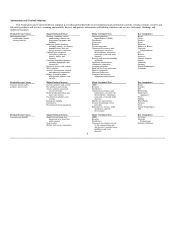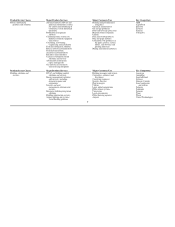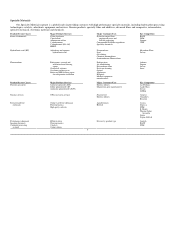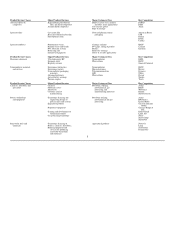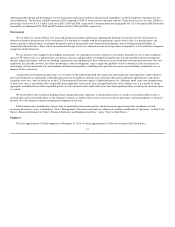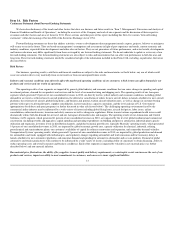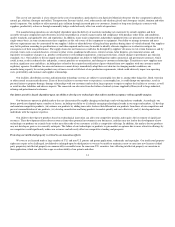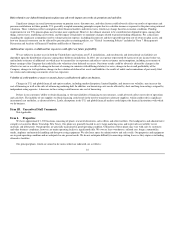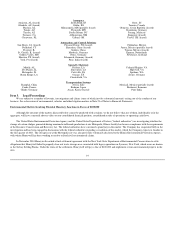Honeywell 2010 Annual Report Download - page 18
Download and view the complete annual report
Please find page 18 of the 2010 Honeywell annual report below. You can navigate through the pages in the report by either clicking on the pages listed below, or by using the keyword search tool below to find specific information within the annual report.
intellectual property rights. Any of these events or factors could diminish or cause us to lose the competitive advantages associated with our intellectual
property, subject us to judgments, penalties and significant litigation costs, and/or temporarily or permanently disrupt our sales and marketing of the affected
products or services.
Our systems are subject to risks from unlawful attempts by others to gain unauthorized access to our information technology systems through the
Internet. The theft and/or unauthorized use or production of our trade secrets and other confidential business information could reduce the value of our
investment in R&D and product development and could subject us to claims by third parties relating to loss of their confidential or proprietary information.
An increasing percentage of our sales and operations is in non-U.S. jurisdictions and is subject to the economic, political, regulatory and other risks of
international operations.
Our international operations, including U.S. exports, comprise a growing proportion of our operating results. Our strategy calls for increasing sales to
and operations in overseas markets, including developing markets such as Mexico, Brazil, China, India, Malaysia, the Middle East and Eastern Europe.
In 2010, 52 percent of our total sales (including products manufactured in the U.S. and in international locations) were outside of the U.S. including 28
percent in Europe and 11 percent in Asia. Risks related to international operations include exchange control regulations, wage and price controls, employment
regulations, foreign investment laws, import, export and other trade restrictions (such as embargoes), changes in regulations regarding transactions with state-
owned enterprises, nationalization of private enterprises, government instability, and our ability to hire and maintain qualified staff and maintain the safety of
our employees in these regions. We are also subject to U.S. laws prohibiting companies from doing business in certain countries, or restricting the type of
business that may be conducted in these countries. The cost of compliance with increasingly complex and often conflicting regulations worldwide can also
impair our flexibility in modifying product, marketing, pricing or other strategies for growing our businesses, as well as our ability to improve productivity
and maintain acceptable operating margins.
As we continue to grow our businesses internationally, our operating results could be increasingly affected by the relative strength of the European and
Asian economies and the impact of exchange rate fluctuations. We do have a policy to reduce the risk of volatility through hedging activities, but such
activities bear a financial cost and may not always be available to us and may not be successful in eliminating such volatility.
We may be required to recognize impairment charges for our long-lived assets or available for sale investments.
At December 31, 2010, the net carrying value of long-lived assets (property, plant and equipment, goodwill and other intangible assets) and available
for sale securities totaled approximately $19.0 billion and $0.3 billion, respectively. In accordance with generally accepted accounting principles, we
periodically assess these assets to determine if they are impaired. Significant negative industry or economic trends, disruptions to our business, unexpected
significant changes or planned changes in use of the assets, divestitures and market capitalization declines may result in impairments to goodwill and other
long-lived assets. An other than temporary decline in the market value of our available for sale securities may also result in an impairment charge. Future
impairment charges could significantly affect our results of operations in the periods recognized. Impairment charges would also reduce our consolidated
shareowners' equity and increase our debt-to-total-capitalization ratio, which could negatively impact our credit rating and access to the public debt and equity
markets.
A change in the level of U.S. Government defense and space funding or the mix of programs to which such funding is allocated could adversely impact
Aerospace's defense and space sales and results of operations.
Sales of our defense and space-related products and services are largely dependent upon government budgets, particularly the U.S. defense budget.
Sales as a prime contractor and subcontractor to the U.S. Department of Defense comprised approximately 33 and 10 percent of Aerospace and total sales,
respectively, for the year ended December 31, 2010. We cannot predict the extent to which total funding and/or funding for individual programs will be
included, increased or reduced as part of the 2011 and subsequent budgets ultimately approved by Congress, or be included in the scope of separate
supplemental appropriations. We also cannot predict the impact of potential changes in priorities due to military transformation and planning and/or the nature
of war-related activity on existing, follow-on or replacement programs. A shift in defense or space spending to programs in which we do not participate and/or
reductions in funding for or termination of existing programs could adversely impact our results of operations.
15


